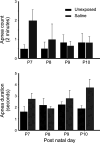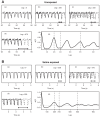Evaluating the control: minipump implantation and breathing behavior in the neonatal rat
- PMID: 27402557
- PMCID: PMC11735011
- DOI: 10.1152/japplphysiol.00080.2016
Evaluating the control: minipump implantation and breathing behavior in the neonatal rat
Abstract
We evaluated genioglossus (GG) gross motoneuron morphology, electromyographic (EMG) activities, and respiratory patterning in rat pups allowed to develop without interference (unexposed) and pups born to dams subjected to osmotic minipump implantation in utero (saline-exposed). In experiment 1, 48 Sprague-Dawley rat pups (Charles-River Laboratories), ages postnatal day 7 (P7) through postnatal day 10 (P10), were drawn from two experimental groups, saline-exposed (n = 24) and unexposed (n = 24), and studied on P7, P8, P9, or P10. Pups in both groups were sedated (Inactin hydrate, 70 mg/kg), and fine-wire electrodes were inserted into the GG muscle of the tongue and intercostal muscles to record EMG activities during breathing in air and at three levels of normoxic hypercapnia [inspired CO2 fraction (FiCO2 ): 0.03, 0.06, and 0.09]. Using this approach, we assessed breathing frequency, heart rate, apnea type, respiratory event types, and respiratory stability. In experiment 2, 16 rat pups were drawn from the same experimental groups, saline-exposed (n = 9) and unexposed (n = 7), and used in motoneuron-labeling studies. In these pups a retrograde dye was injected into the GG muscle, and the brain stems were subsequently harvested and sliced. Labeled GG motoneurons were identified with microscopy, impaled, and filled with Lucifer yellow. Double-labeled motoneurons were reconstructed, and the number of primary projections and soma volumes were calculated. Whereas pups in each group exhibited the same number (P = 0.226) and duration (P = 0.093) of respiratory event types and comparable motoneuron morphologies, pups in the implant group exhibited more central apneas and respiratory instability relative to pups allowed to develop without interference.
Keywords: apnea; control; motoneuron; upper airway.
Copyright © 2016 the American Physiological Society.
Figures





Similar articles
-
Tonically discharging genioglossus motor units show no evidence of rate coding with hypercapnia.J Neurophysiol. 2010 Mar;103(3):1315-21. doi: 10.1152/jn.00686.2009. Epub 2010 Jan 6. J Neurophysiol. 2010. PMID: 20053847 Free PMC article.
-
Coordination of intrinsic and extrinsic tongue muscles during spontaneous breathing in the rat.J Appl Physiol (1985). 2004 Feb;96(2):440-9. doi: 10.1152/japplphysiol.00733.2003. Epub 2003 Oct 3. J Appl Physiol (1985). 2004. PMID: 14527967
-
Co-activation of tongue protrudor and retractor muscles during chemoreceptor stimulation in the rat.J Physiol. 1998 Feb 15;507 ( Pt 1)(Pt 1):265-76. doi: 10.1111/j.1469-7793.1998.265bu.x. J Physiol. 1998. PMID: 9490849 Free PMC article.
-
Respiratory-related control of extrinsic tongue muscle activity.Respir Physiol. 1997 Nov;110(2-3):295-306. doi: 10.1016/s0034-5687(97)00095-9. Respir Physiol. 1997. PMID: 9407623 Review.
-
Biomechanical properties of the human upper airway and their effect on its behavior during breathing and in obstructive sleep apnea.J Appl Physiol (1985). 2014 Feb 1;116(3):314-24. doi: 10.1152/japplphysiol.00539.2013. Epub 2013 Jul 3. J Appl Physiol (1985). 2014. PMID: 23823151 Review.
References
-
- Bailey EF, Fregosi RF. Coordination of intrinsic and extrinsic tongue muscles during spontaneous breathing in the rat. J Appl Physiol (1985) 96: 440–449, 2004. - PubMed
-
- Bailey EF, Huang YH, Fregosi RF. Anatomic consequences of intrinsic tongue muscle activation. J Appl Physiol (1985) 101: 1377–1385, 2006. - PubMed
-
- Ballanyi K, Ruangkittisakul A. Structure-function analysis of rhythmogenic inspiratory pre-Botzinger complex networks in “calibrated” newborn rat brainstem slices. Respir Physiol Neurobiol 168: 158–178, 2009. - PubMed
MeSH terms
Grants and funding
LinkOut - more resources
Full Text Sources
Other Literature Sources

